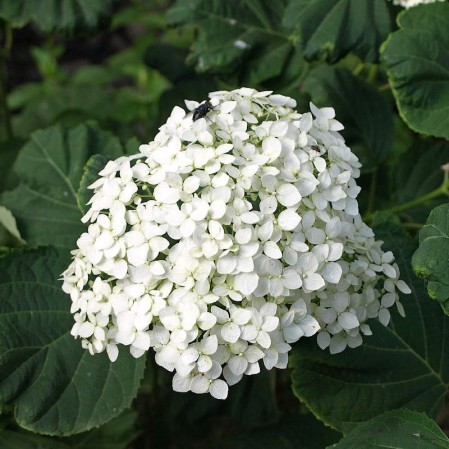Wild Hydrangea Seeds
Hydrangea arboescens
- HOW TO GROW
- FAST FACTS
HOW TO GROW
Sowing: Direct sow in spring, pressing the seeds into the surface of the soil; these seeds need light to germinate. Keep the soil moist until germination, which usually occurs within 10-14 days. To start indoors, place several seeds together in individual peat pots; keep the soil moist and in a location in indirect sunlight.
Growing: This plant needs consistent moisture, especially when becoming established. It can tolerate very moist soil that drains well, but tends to drop its foliage in drought conditions. This plant adapts well to clay soil as well as shallow or rocky areas. Deadhead the spent blossoms for prolonged blooming. In good conditions this plant will spread rapidly by suckers, becoming rather weedy if left to itself; remove the suckers to prevent this. Cut back the plant to 8-10" during the time of winter or early spring dormancy.
Harvesting: For fresh flowers, cut long stems of flowers that have just opened and place them in water immediately; strip the leaves that will fall below the water. These also make excellent dried flowers; bundle the stems and hang them upside down in a warm, dark place with good ventilation until dry.
Seed Saving: At the end of the season, the flowers will become dry and papery; shake the clusters of open seed heads over a container to remove the tiny brown seeds. Store the cleaned seed in a cool, dry place.
FAST FACTS
Latin Name: Hydrangea arboescens
Species Origin: US Native Wildflower
Type: Native Wildflowers
Life Cycle: Perennial
USDA Zones: 5, 6, 7, 8, 9
US Regions: California, Mountain, Arid/Desert, Plains/Texas, Midwest, Northern, Northeast, Southeast
Seeds per Ounce: 400,000
Stratification: No Stratification
Germination Ease: No Stratification
Sunlight: Part Sun
Height: 48 Inches
Color: White
Bloom Season: Blooms Early Summer, Blooms Late Summer
DESCRIPTION
HOW TO GROW
Sowing: Direct sow in spring, pressing the seeds into the surface of the soil; these seeds need light to germinate. Keep the soil moist until germination, which usually occurs within 10-14 days. To start indoors, place several seeds together in individual peat pots; keep the soil moist and in a location in indirect sunlight.
Growing: This plant needs consistent moisture, especially when becoming established. It can tolerate very moist soil that drains well, but tends to drop its foliage in drought conditions. This plant adapts well to clay soil as well as shallow or rocky areas. Deadhead the spent blossoms for prolonged blooming. In good conditions this plant will spread rapidly by suckers, becoming rather weedy if left to itself; remove the suckers to prevent this. Cut back the plant to 8-10" during the time of winter or early spring dormancy.
Harvesting: For fresh flowers, cut long stems of flowers that have just opened and place them in water immediately; strip the leaves that will fall below the water. These also make excellent dried flowers; bundle the stems and hang them upside down in a warm, dark place with good ventilation until dry.
Seed Saving: At the end of the season, the flowers will become dry and papery; shake the clusters of open seed heads over a container to remove the tiny brown seeds. Store the cleaned seed in a cool, dry place.
FAST FACTS
Latin Name: Hydrangea arboescens
Species Origin: US Native Wildflower
Type: Native Wildflowers
Life Cycle: Perennial
USDA Zones: 5, 6, 7, 8, 9
US Regions: California, Mountain, Arid/Desert, Plains/Texas, Midwest, Northern, Northeast, Southeast
Seeds per Ounce: 400,000
Stratification: No Stratification
Germination Ease: No Stratification
Sunlight: Part Sun
Height: 48 Inches
Color: White
Bloom Season: Blooms Early Summer, Blooms Late Summer




